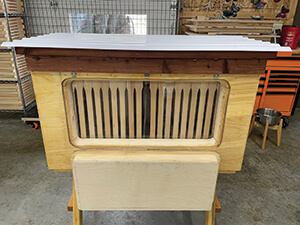
Building my 2023 Layens Hives
During the winter months I enjoy building a few Layens hives to use or sell in the early spring. I thought you and your readers would enjoy seeing these beehives. I start with unassembled standard Layens frames from Horizontalhive.com. I make a slit in the top bar of the frame before I assemble them. Then I can insert a strip of wax foundation to encourage the bees to stay within the frames as they build out the comb. The frames from Horizontal Hive are also pre-drilled to accept wires for those who want to have wired frames if they may have a large honey extractor.
During the summer it is so interesting to look in the hives and see the bees working, so I make two changes in the Layens hives to accommodate watching the bees without disturbing them, and without the need for protective clothing. Visitors young and old enjoy seeing inside without the need of a bee veil. First, the divider board is clear Plexiglas (Photo 1) so that you can look in the hive after installing a package of bees and watch their progress. Then you know when to add more empty frames as they fill the original six or so frames you left them when you installed the package. It is really enjoyable and educational to see.
Second, I made a side window that can be opened, with Plexiglas that allows you to see the busy bees on the frames (Photo 2). This is also enjoyable and educational. Seeing the inside of a hive has sparked honey bee interest in both young and old friends and visitors!
The walls and floor of the hive have 1 ½” Styrofoam insulation sandwiched between 3/8” and ½” plywood, resulting in 2 3/8” thick walls for both summer and winter comfort of the bees. The roof has more insulation, 2”, as most heat is exchanged through the top. Steel or plastic on the hive tops keeps the rain out. I also added a metal L channel for the frames to rest on inside.
The outside colors, roofs, and décor are different on each hive, as Photo 3 shows. I enjoy doing the different colors and looks! However, the inside measurements of each hive are the exact same to accommodate 20 Layens frames and the proper bee spaces. The Horizontal Hive website by Dr. Leo Sharashkin is really helpful with the building plans’ dimensions.
I left entrances at both ends because of different management practices of beekeepers. Two entrances will allow two colonies of 10 Layens frames each if desired. My bees seem to fill 17 to 20 frames so I use only one end entrance and leave the plug in the opposite end.
The entrances are ¾” by 6” to allow the heavy traffic of the main pollen gathering season, and they also have an entrance reducer to help keep the cold out in the winter.
Beekeeping is so educational, so enjoyable, so beneficial, and honey is a wonderful and delicious healthful food!! I love being a backyard beekeeper!!
Thank you for your wonderful magazine that continues to inspire and educate me!
Tony Seitz
Billings, Montana
Standardizing Frames
I read Jim Berndt’s article “Which Type of Hive is Right for You?” [September 2022] and was a little disappointed that he hadn’t mentioned hives using just one size frame so that dark combs from the brood box can, more easily, be worked out of the hive. But I understood that all the books promote the large brood nest and the smaller supers so I let it go past.
However, I was very pleased to read Derek Lewis’ [November] letter in which he had solved the problem by standardizing his frames all to mediums so that he can do that.
I went straight into commercial beekeeping here in Western Australia back in 1954 and never met any hobbyists until my wife and I took on the WA agency for Guilfoyle’s beekeeping goods made in Queensland in the 1970s and I was surprised to hear of the problems that some of the older ones were having because they had followed the commercial guys’ practice of running all deep boxes. Brood box and two deeps either 8- or 10-frame.
At the time I was running 320 hives which, because of our several crops each year, is regarded as full-time commercial, so I put a lot of thought into the subject.
I decided that my 8-frame boxes would all be cut down to medium and made into side-entrance brood boxes with a cleat along the top of the long sides; and all the 10-frame boxes would, likewise, be cut down but used as supers.
One of the Dept. of Ag inspectors called in while I was cutting the boxes down and was very critical of the idea. But, later, he called in again and had changed his mind. He measured the brood area in my 8-frame mediums and then measured that in the hives of some top producers’ 10-frame hives and found there was no difference. My mediums had just as much brood but had no honey stored down there.
I suspect that one reason the deep supers are so popular in Australia is because much of our honey comes from eucalypts and many of them produce low-grade pollen so the brood box becomes loaded with honey and the combs need to be put into the supers for later extraction. The next flow might involve a long shift to a different euc whose pollen is more nutritious.
Stan Taylor
taybees@westnet.com.au
Western Australia


